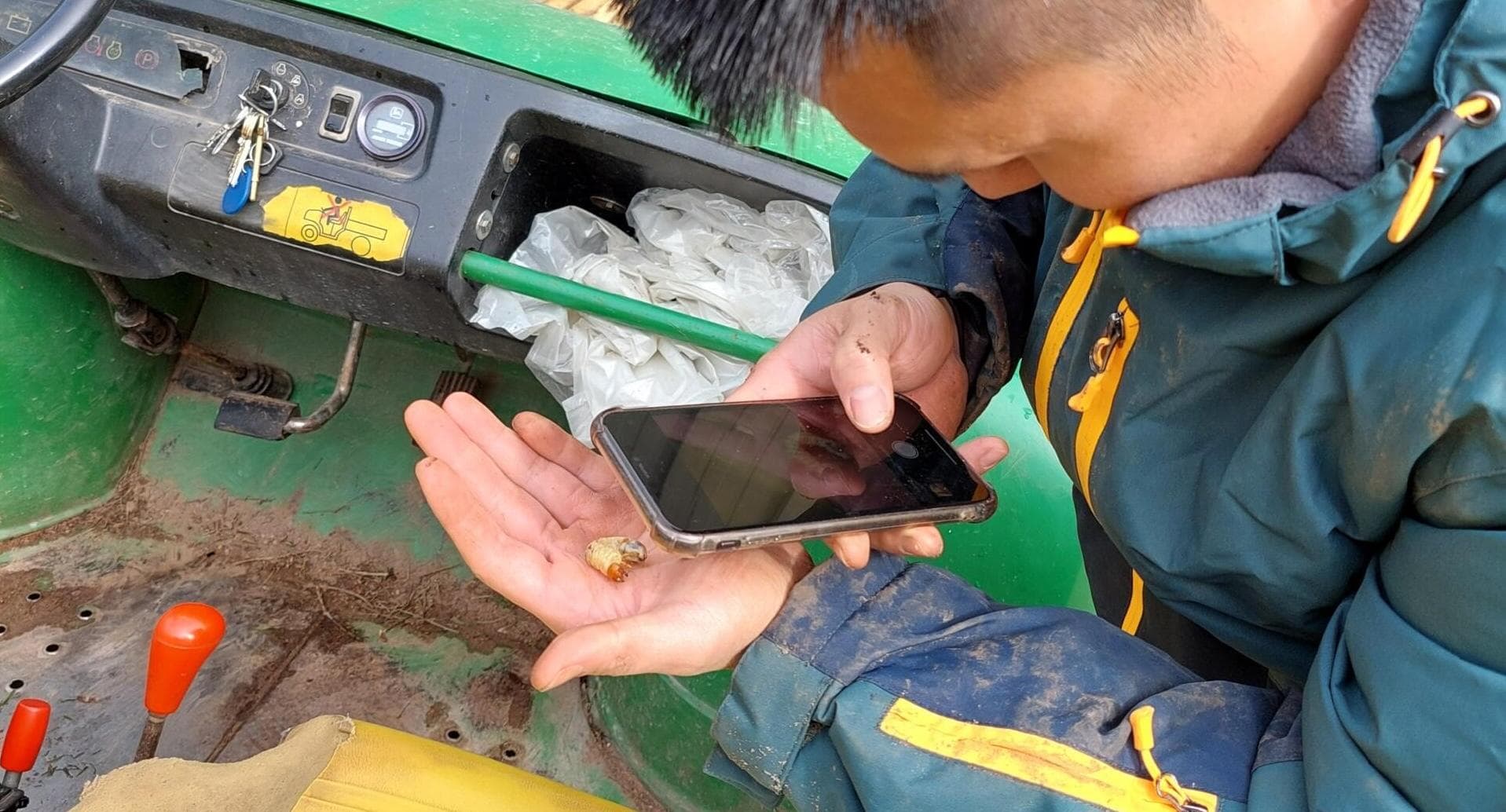The last couple of weeks the team and myself have had the great pleasure of touring some of our best operation pollinator sites with Mike Edwards (watch this space for an article soon). I picked up a few great tips from him that I'll quickly share with you and then below is a brilliant article that he and John Nicholson have written. He's also given me a similar article on heather and Gorse on the golf course which I'll share soon.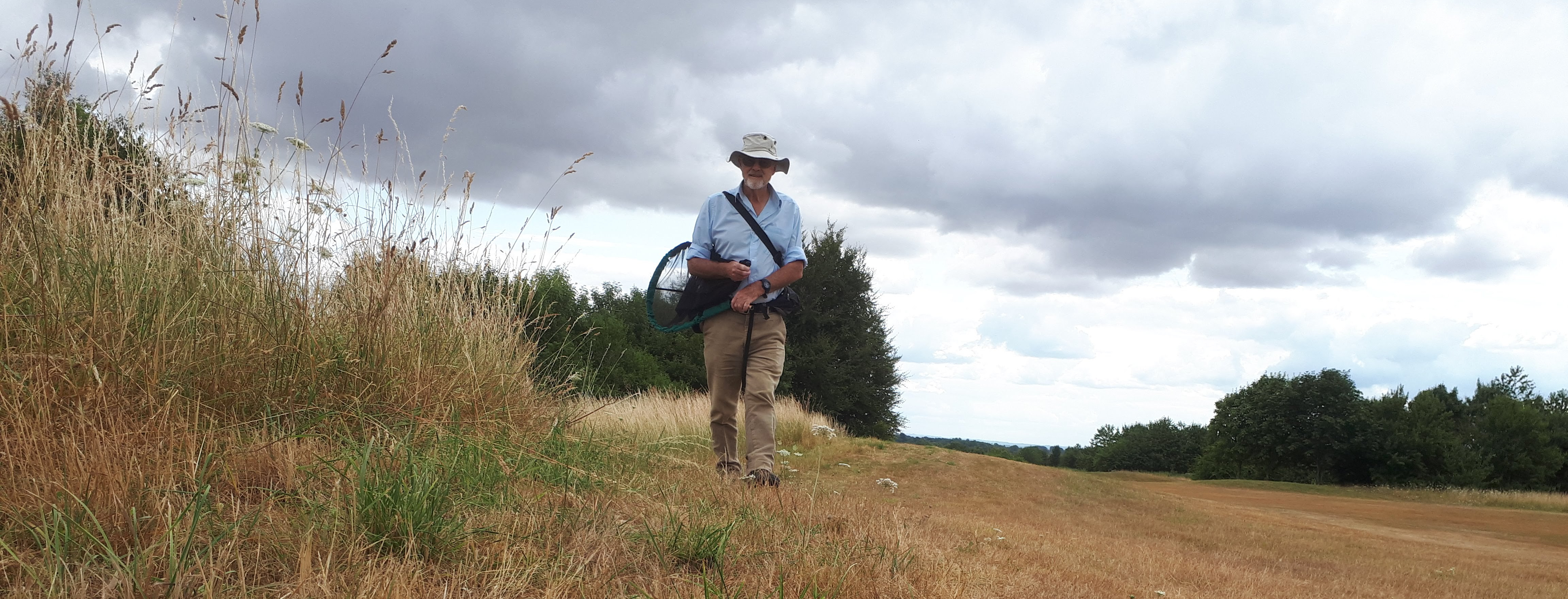 An Ecologist and an (ex) Course manager combine for some useful tips:
An Ecologist and an (ex) Course manager combine for some useful tips:
- Don't cut all your long roughs at the same time - Spring and summer cuts are incredibly valuable too
- Try to cut some areas 2 or 3 times a year - the more intensively you manage an area the quicker you can thn it out
- Manage the time you have available - if some key areas get cut and removed 3 times a year but other out of play areas only get cut 1 in 3 years that gives more diversity and begins to grade the playability for the golfer
- Dont worry too much about the timings, do it when you can - insects will migrate to another area
- If you can't remove grass clippings - makes sure the clippings are cut up as fine as possible
- Invest your time in more intensive management in key areas - make these work in places the golfers will appreciate it
General Principles for the Management of Grass Roughs
What is the rough? On many golf courses the ‘rough’ is just that, a bit of unkempt land which gets looked at occasionally and even more occasionally some management - probably as a result of exceptionally persistent complaints from players. Given the pressures on course staff to keep the recognised playing surfaces in good condition this state of affairs is not surprising. However, the rough is actually as much a part of the course and its strategy as the fairway - indeed the level of penalty offered by the rough should influence strategic play with risk and reward being as big a consideration as sheer hitting power. Penal roughs remove this strategic component completely. What makes a ‘good rough’? As indicated above, this is all to do with the level of penalty offered when a ball lands in the rough. What is wanted is a surface which offers resistance to being played out of, but it is possible to do so with a bit of skill and thought; and where the ball can be found readily - the time taken up by searching for lost balls and consequent delay to everyone’s play is a major issue for all clubs. Harry Colt summed up the requirements most eloquently in his book on golf course design. “The characteristics of a hazard are that it should be difficult but not impossible to play out of; that it should not cause lost balls; and that strokes played out of it should be calculable as regards strength and direction, and should depend for their success on skill and not brute force alone.” H S Colt 1920 Essays on Golf-Course Architecture It is therefore necessary to ensure any rough on a golf course is composed of the fine grasses that allow a ball to be found and a recovery shot attempted. The height and density of the vegetation are critical here. Both relate to the amount of nutrient and moisture available to promote plant growth. Controlling the availability of these requires consideration of the same processes as are used in getting good playing surfaces - albeit looking for different outcomes and restricting these, rather than providing!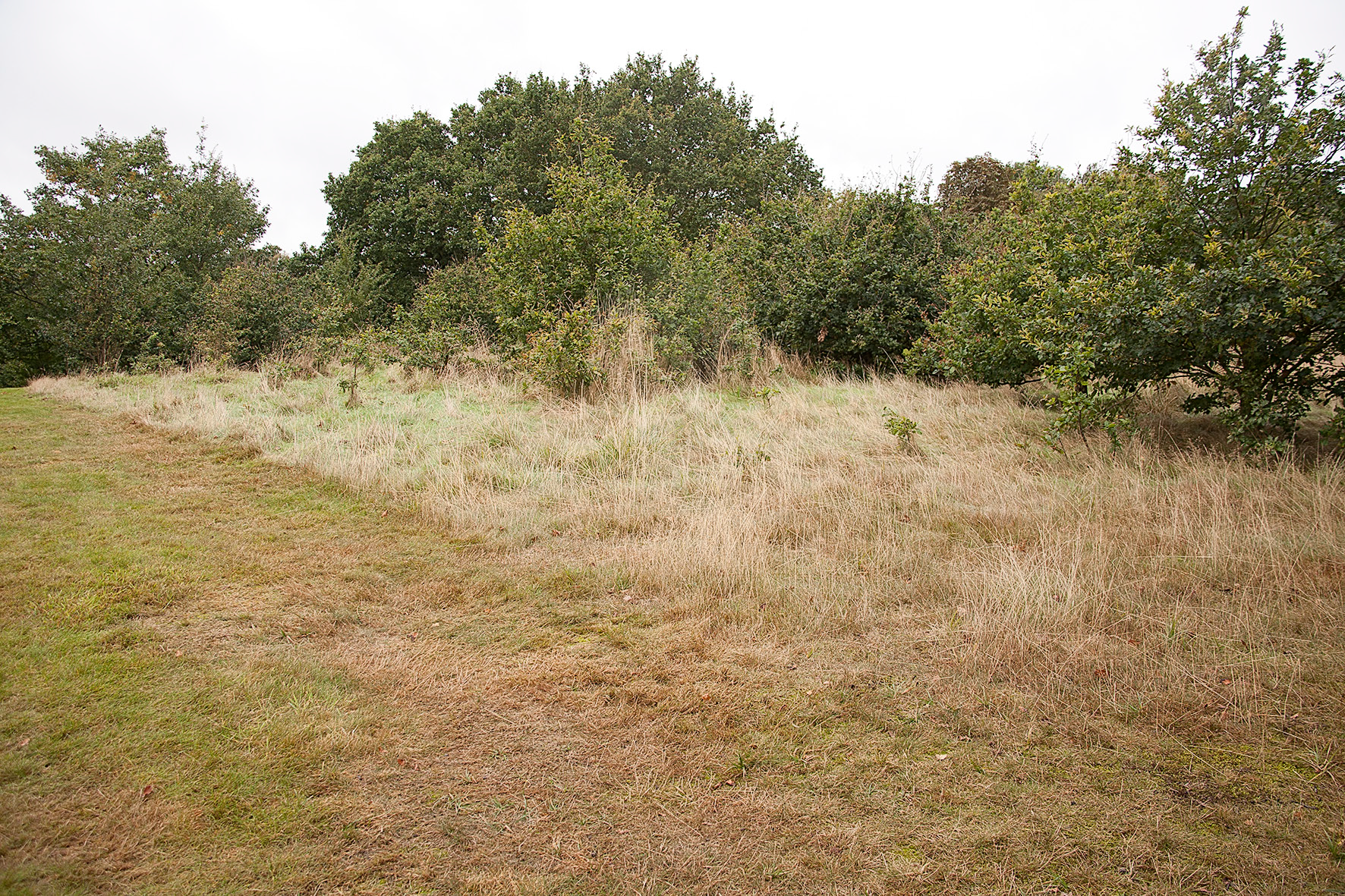 A typical neglected rough: tall, dense grass, emerging trees Certainly not a place to risk playing anywhere near!
How does it work?
Greens especially are fertilised, watered well and cut severely; basically the fertiliser and water are trying to make up for the continual removal of plant material. For the rough, removing the sources of nutrient, restricting water availability and cutting more often than once a year can slow down grass growth considerably. Cutting regimes are the simplest way to start opening the structure of grasslands - essential both for finding balls and increasing playability. This approach is already used on many courses to create ‘semi-rough’. Creating a slightly more serious hazard is all that is needed. There are issues with the variability of the hazard - a newly cut grassland is not the same hazard as one a month afterwards. Rotating the times of cutting can be of use here. Above all, it must be understood by staff and members alike that there is no such thing as a ‘static’ situation where a growing plant is concerned, just a limit to acceptable change, and at this point appropriate management becomes essential.
Leaving cuttings to rot on the surface - known as ‘cut and drop’ - is one of the most effective ways to build up dead grass thatch, increase water retention at the roots and retain/capture nutrients. All these work against developing the open-structured turf which provides the conditions required for a good rough. Although cut and drop may be cheap on a ‘per management’ basis it costs severely on a longer term one.
At its simplest level these effects can be reduced by using a flail mower, rather than a topper, as this breaks the grass up more. Cutting in dry windy weather also helps the cuttings to dry off and distribute more evenly, rather than landing in a soggy heap. This can be further improved by running over the cut material with the flail a second time a couple of days later. Where it is the only option available it is important to cut before the growth gets long and dense, at least twice a year.
A typical neglected rough: tall, dense grass, emerging trees Certainly not a place to risk playing anywhere near!
How does it work?
Greens especially are fertilised, watered well and cut severely; basically the fertiliser and water are trying to make up for the continual removal of plant material. For the rough, removing the sources of nutrient, restricting water availability and cutting more often than once a year can slow down grass growth considerably. Cutting regimes are the simplest way to start opening the structure of grasslands - essential both for finding balls and increasing playability. This approach is already used on many courses to create ‘semi-rough’. Creating a slightly more serious hazard is all that is needed. There are issues with the variability of the hazard - a newly cut grassland is not the same hazard as one a month afterwards. Rotating the times of cutting can be of use here. Above all, it must be understood by staff and members alike that there is no such thing as a ‘static’ situation where a growing plant is concerned, just a limit to acceptable change, and at this point appropriate management becomes essential.
Leaving cuttings to rot on the surface - known as ‘cut and drop’ - is one of the most effective ways to build up dead grass thatch, increase water retention at the roots and retain/capture nutrients. All these work against developing the open-structured turf which provides the conditions required for a good rough. Although cut and drop may be cheap on a ‘per management’ basis it costs severely on a longer term one.
At its simplest level these effects can be reduced by using a flail mower, rather than a topper, as this breaks the grass up more. Cutting in dry windy weather also helps the cuttings to dry off and distribute more evenly, rather than landing in a soggy heap. This can be further improved by running over the cut material with the flail a second time a couple of days later. Where it is the only option available it is important to cut before the growth gets long and dense, at least twice a year.
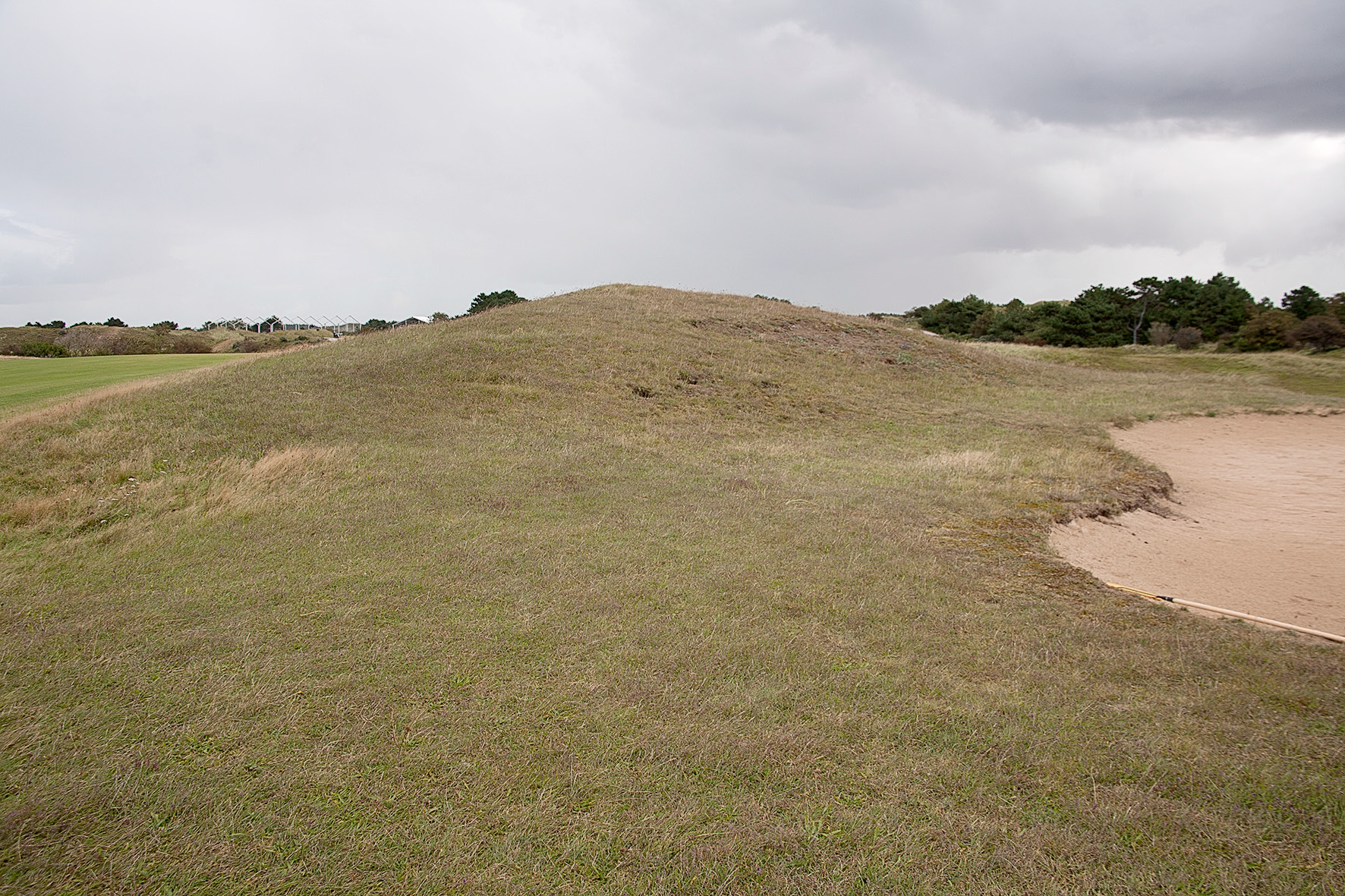 A well-kept rough - long enough to provide a hazard, short enough to risk playing over. The use of the bunker adds to the hazard, but the whole system is not penal.
Where grass is very tall and dense, not having been cut to any extent for a considerable time, one effective initial approach is to treat it like a crop and cut and bale, taking the bales away, ideally off-site. Subsequent management needs to ensure that such a situation is never reached again. However, for all cuts it is best to use a machine which will cut and remove in one go, making sure to cut long before the grassland reaches a tall, dense condition. Although some outfront horizontal action mowers may be fitted with a collection system, a flail/scarifier-collector, such as those made by Amazone, Trilo or Rytec, offers far greater versatility, largely through the plane in which the cutters work. Cylinder-pattern blades cut into the turf, opening it up in much the same way as grazing cattle pull grass, rather than slicing it off like sheep. They can also be set to scarify into the turf, helping drainage, increasing light and warmth at the base of the turf and decreasing the build-up of thatch. Indeed, during a series of visits to clubs as part of the Syngenta ‘Operation Golf’ programme many managers commented on the vast improvement made through aggressive scarifying and did not consider that using any growth regulator was worthwhile - not an outcome which Syngenta had expected!
It is not often appreciated that, quite apart from the direct build-up of dead grass, there are other ways in which the rough may accumulate nutrients, most notably leaf-drop from adjacent trees and run-off from watering/fertilising other playing surfaces.
Besides being taken away by grazing animals (= cutting and collecting machinery for golf courses), nutrients in grasslands slowly percolate down through the soil, the rate depending on the nature of the soil itself with sand and chalk/limestone losing nutrient more quickly than clays. Trees act as nutrient pumps, bringing this hidden nutrient back to the surface via their deep roots to feed their leaves, which then drop to the surface when they die. This process of nutrient and humus accumulation from grass and trees leads to the development of fertile ‘brown earth’ soils, which promote plant growth and have been highly valued for crop production. Slowing down this process is essential for the establishment of a low-management rough. Hence, in areas where an open-structured grassland is required, tree planting should be kept to a minimum, with due regard to considerations of safety and separation. The type of tree also makes a big difference, small-leaved species, such as Pine or Birch, having much less input than large-leaved ones such as Sweet Chestnut or Norway Maple.
A well-kept rough - long enough to provide a hazard, short enough to risk playing over. The use of the bunker adds to the hazard, but the whole system is not penal.
Where grass is very tall and dense, not having been cut to any extent for a considerable time, one effective initial approach is to treat it like a crop and cut and bale, taking the bales away, ideally off-site. Subsequent management needs to ensure that such a situation is never reached again. However, for all cuts it is best to use a machine which will cut and remove in one go, making sure to cut long before the grassland reaches a tall, dense condition. Although some outfront horizontal action mowers may be fitted with a collection system, a flail/scarifier-collector, such as those made by Amazone, Trilo or Rytec, offers far greater versatility, largely through the plane in which the cutters work. Cylinder-pattern blades cut into the turf, opening it up in much the same way as grazing cattle pull grass, rather than slicing it off like sheep. They can also be set to scarify into the turf, helping drainage, increasing light and warmth at the base of the turf and decreasing the build-up of thatch. Indeed, during a series of visits to clubs as part of the Syngenta ‘Operation Golf’ programme many managers commented on the vast improvement made through aggressive scarifying and did not consider that using any growth regulator was worthwhile - not an outcome which Syngenta had expected!
It is not often appreciated that, quite apart from the direct build-up of dead grass, there are other ways in which the rough may accumulate nutrients, most notably leaf-drop from adjacent trees and run-off from watering/fertilising other playing surfaces.
Besides being taken away by grazing animals (= cutting and collecting machinery for golf courses), nutrients in grasslands slowly percolate down through the soil, the rate depending on the nature of the soil itself with sand and chalk/limestone losing nutrient more quickly than clays. Trees act as nutrient pumps, bringing this hidden nutrient back to the surface via their deep roots to feed their leaves, which then drop to the surface when they die. This process of nutrient and humus accumulation from grass and trees leads to the development of fertile ‘brown earth’ soils, which promote plant growth and have been highly valued for crop production. Slowing down this process is essential for the establishment of a low-management rough. Hence, in areas where an open-structured grassland is required, tree planting should be kept to a minimum, with due regard to considerations of safety and separation. The type of tree also makes a big difference, small-leaved species, such as Pine or Birch, having much less input than large-leaved ones such as Sweet Chestnut or Norway Maple.
 The very worst cutting management for good roughs- cutting and dropping - here on a farm margin, not a golf course. Going over this again with the flail would help considerably.
The very worst cutting management for good roughs- cutting and dropping - here on a farm margin, not a golf course. Going over this again with the flail would help considerably.
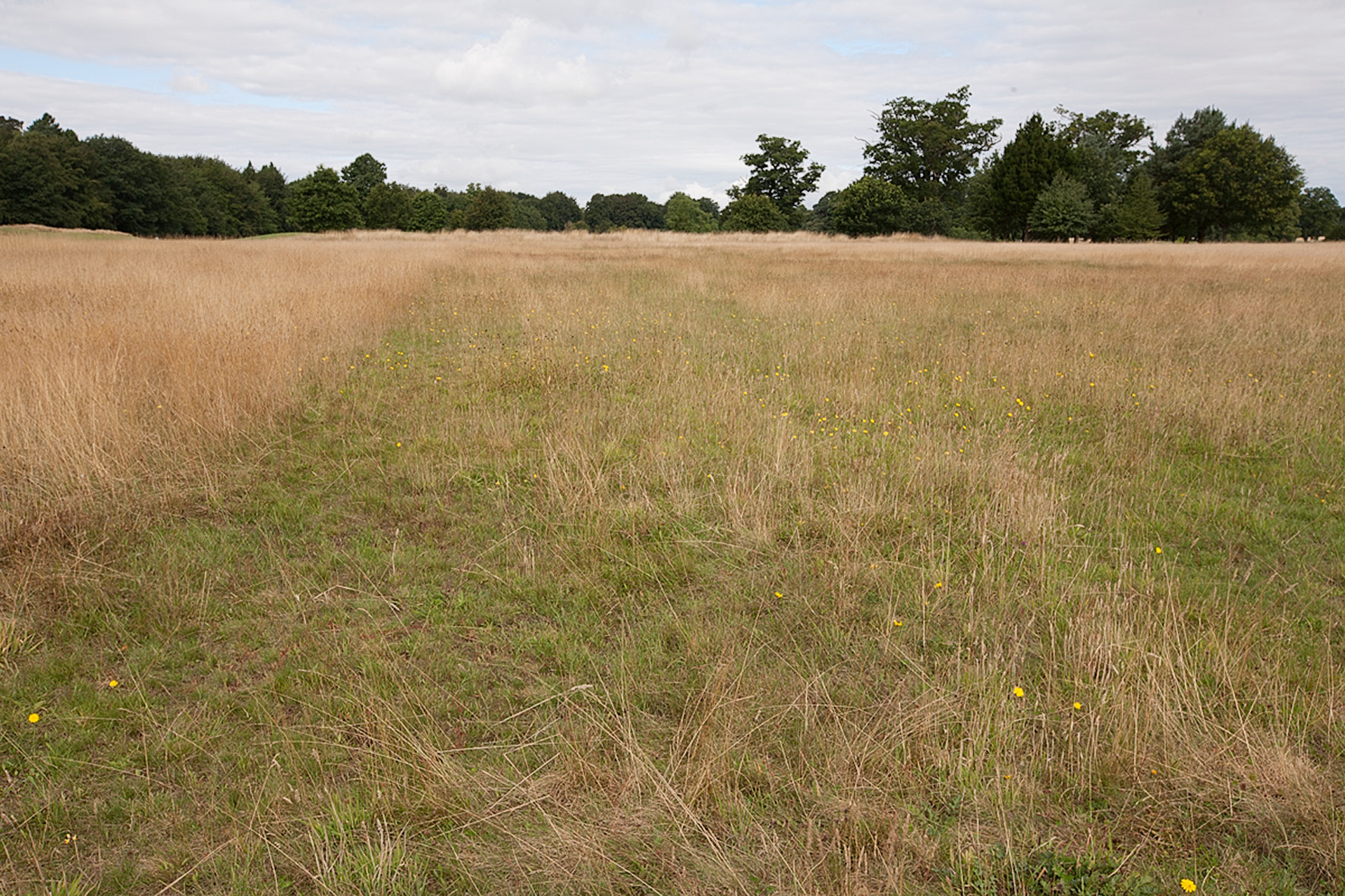 The rough on the right has been scarified, nothing else. Note the greater number of wild flowers, a far wider environmental benefit than the tall, rank grass on the left.
Leaf-drop from trees is a very effective fertiliser, not to mention nuisance on playing surfaces!
The rough on the right has been scarified, nothing else. Note the greater number of wild flowers, a far wider environmental benefit than the tall, rank grass on the left.
Leaf-drop from trees is a very effective fertiliser, not to mention nuisance on playing surfaces! Watering, of greens, tees or fairways provides another route by which unwanted nutrients may enter the system. All will be familiar with the ring of brighter green around tees, on tee-mounds as well as on fairways adjacent to greens. In such situations the established ‘short turf’ management regimes probably control the build-up of longer, denser grasses. Much less is appreciated about the potential for nutrient movement from fairways, especially where these are fed and watered. With run-off a lot will depend upon the local lie of the land, but poorly placed, or directed, sprinklers can be very influential, quite apart from major considerations regarding the cost/desirability or agronomic/ecological (yes, these are ecological situations) outcomes.
Which grasses and why?
The best structured and playable grass roughs are comprised of very different grass species from tall, unplayable ones. In these taller roughs, some grass species, notably Cocksfoot Dactylis glomerata; False Oat Grass Arrhenatherum elatius; Tufted Hair Grass Deschampsia cespitosa and, in damp, acidic conditions, Purple Moor Grass Molinia caerulea, may build up tough basal tussocks, making walking among them difficult - even in extreme situations, dangerous - as well as hiding balls very well. Pity the poor golfer who, unaware of the large tussock straight in front of their swing, finds all momentum suddenly taken away and very sore arms (if lucky) replacing this. Fortunately the ecological niche of these grasses means that they are not very tolerant of repeated cutting, although once they are established they may respond to any extended reduction in cutting pressure, re-creating the large tussocks.
Watering, of greens, tees or fairways provides another route by which unwanted nutrients may enter the system. All will be familiar with the ring of brighter green around tees, on tee-mounds as well as on fairways adjacent to greens. In such situations the established ‘short turf’ management regimes probably control the build-up of longer, denser grasses. Much less is appreciated about the potential for nutrient movement from fairways, especially where these are fed and watered. With run-off a lot will depend upon the local lie of the land, but poorly placed, or directed, sprinklers can be very influential, quite apart from major considerations regarding the cost/desirability or agronomic/ecological (yes, these are ecological situations) outcomes.
Which grasses and why?
The best structured and playable grass roughs are comprised of very different grass species from tall, unplayable ones. In these taller roughs, some grass species, notably Cocksfoot Dactylis glomerata; False Oat Grass Arrhenatherum elatius; Tufted Hair Grass Deschampsia cespitosa and, in damp, acidic conditions, Purple Moor Grass Molinia caerulea, may build up tough basal tussocks, making walking among them difficult - even in extreme situations, dangerous - as well as hiding balls very well. Pity the poor golfer who, unaware of the large tussock straight in front of their swing, finds all momentum suddenly taken away and very sore arms (if lucky) replacing this. Fortunately the ecological niche of these grasses means that they are not very tolerant of repeated cutting, although once they are established they may respond to any extended reduction in cutting pressure, re-creating the large tussocks.
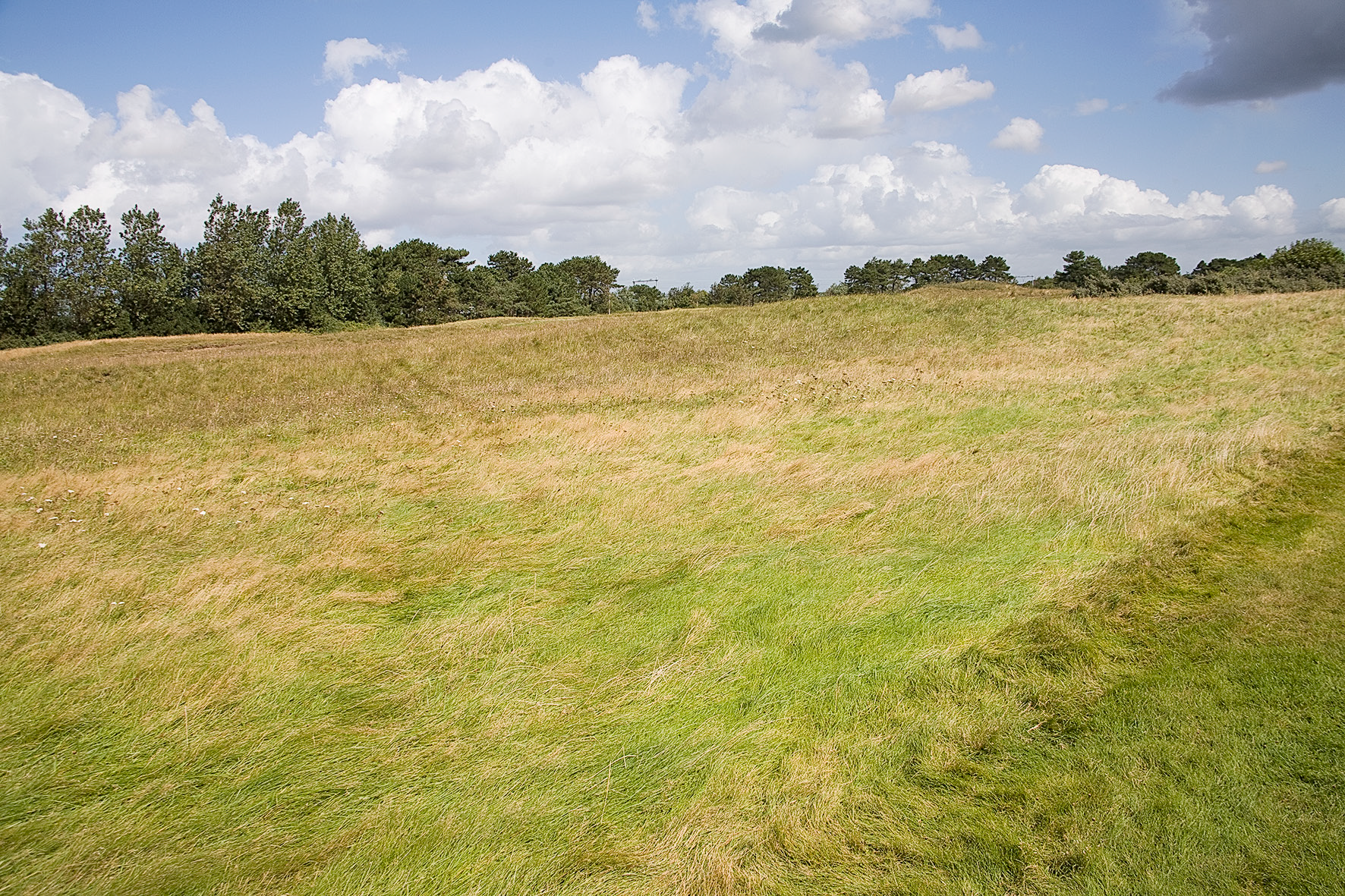 The bright green, dense patch of grass is the result of water, with its dissolved chemicals, being applied on the adjacent fairway to the right. You can see the circular margin of the sprinkler pattern.
Good, open-structured roughs should have a preponderance of low-growing, fine, non-rhizomatous grasses; this means that keeping the overall growth down is an important part of providing the conditions which favour them. This is especially so in damp conditions - managing such areas as semi-rough has much to recommend it. The rhizomatous Bents, notably Common or Brown-top Agrostis capillaris, and Perennial Rye-grass Lolium perenne have often been included in amenity and sports turf mixtures, especially the cheaper ones on account of their very good wearing properties. However, as the rhizomes tend to knit together, they can become very dominant, crowding out the other fine grasses in the rough. (They have been described as green concrete, very apt!) Better species for the rough, although less wear-resistant, include Sheep’s Fescue Festuca ovina; Crested Dogstail Cynosurus cristatus; Slender-creeping Red-fescue Festuca rubra Sweet Vernal Grass Anthoxanthum odoratum and Smooth-stalked Meadow Grass Poa pratensis (this is a perennial species, NOT the annual Meadow Grass which is a problem on courses). The actual species will vary depending on the nature of the soil and drainage. If sowing an area which is destined to be rough, my preference is not to include any Bent, as it will get there on its own! There is very good advice regarding grasses and their suitability on the Emorsgate website https://wildseed.co.uk and a phone call to Richard Brown or Mark Schofield will always get a helpful response if one is looking to buy seed.
Environmental considerations
There has been a tendency to encourage leaving grasses to grow long on courses for ‘environmental reasons’. Whilst it is perfectly true that long, dense grasslands provide good habitat for voles and therefore provide good hunting grounds for Kestrels or Owls, this is not a component of the countryside which is in terribly short supply - tussocky grass is the commonest non-cropped environment on farmland, usually achieved by doing nothing to land taken out of production. As it does nothing for the play of golf, there is little reason to encourage large amounts of it on courses either. At the very least, such taller graslands should be removed far away from play. Even then they will benefit from a complete cut and remove every 3 years or so.
The bright green, dense patch of grass is the result of water, with its dissolved chemicals, being applied on the adjacent fairway to the right. You can see the circular margin of the sprinkler pattern.
Good, open-structured roughs should have a preponderance of low-growing, fine, non-rhizomatous grasses; this means that keeping the overall growth down is an important part of providing the conditions which favour them. This is especially so in damp conditions - managing such areas as semi-rough has much to recommend it. The rhizomatous Bents, notably Common or Brown-top Agrostis capillaris, and Perennial Rye-grass Lolium perenne have often been included in amenity and sports turf mixtures, especially the cheaper ones on account of their very good wearing properties. However, as the rhizomes tend to knit together, they can become very dominant, crowding out the other fine grasses in the rough. (They have been described as green concrete, very apt!) Better species for the rough, although less wear-resistant, include Sheep’s Fescue Festuca ovina; Crested Dogstail Cynosurus cristatus; Slender-creeping Red-fescue Festuca rubra Sweet Vernal Grass Anthoxanthum odoratum and Smooth-stalked Meadow Grass Poa pratensis (this is a perennial species, NOT the annual Meadow Grass which is a problem on courses). The actual species will vary depending on the nature of the soil and drainage. If sowing an area which is destined to be rough, my preference is not to include any Bent, as it will get there on its own! There is very good advice regarding grasses and their suitability on the Emorsgate website https://wildseed.co.uk and a phone call to Richard Brown or Mark Schofield will always get a helpful response if one is looking to buy seed.
Environmental considerations
There has been a tendency to encourage leaving grasses to grow long on courses for ‘environmental reasons’. Whilst it is perfectly true that long, dense grasslands provide good habitat for voles and therefore provide good hunting grounds for Kestrels or Owls, this is not a component of the countryside which is in terribly short supply - tussocky grass is the commonest non-cropped environment on farmland, usually achieved by doing nothing to land taken out of production. As it does nothing for the play of golf, there is little reason to encourage large amounts of it on courses either. At the very least, such taller graslands should be removed far away from play. Even then they will benefit from a complete cut and remove every 3 years or so.
 These Harebells used to grow in an area of fairly short rough; they cannot compete in tall dense swards and eventually disappear. The mowing regime was slackened and this is the result. Note the developing tussock of Cock’s-foot Grass to the left of the Harebell
Shorter, open-structured grasslands, on the other hand, both improve the playing situation for golf, and have the potential for much greater biodiversity benefit, especially if they have a wider floral diversity than grasses alone. Such floral diversity provides a wider set of potential food plants for insects, and their predators: birds, bats, lizards, frogs and toads, as well as being more biodiverse in themselves. One major reason for this is the increased light, and consequently warmth, in such open grasslands; no-one enjoys being cold! There will never be a situation which suits everything equally well. Most organisms will be ‘surviving’ under any set of conditions, so make the environment one which suits the golf and those aspects of biodiversity which like similar conditions.
These Harebells used to grow in an area of fairly short rough; they cannot compete in tall dense swards and eventually disappear. The mowing regime was slackened and this is the result. Note the developing tussock of Cock’s-foot Grass to the left of the Harebell
Shorter, open-structured grasslands, on the other hand, both improve the playing situation for golf, and have the potential for much greater biodiversity benefit, especially if they have a wider floral diversity than grasses alone. Such floral diversity provides a wider set of potential food plants for insects, and their predators: birds, bats, lizards, frogs and toads, as well as being more biodiverse in themselves. One major reason for this is the increased light, and consequently warmth, in such open grasslands; no-one enjoys being cold! There will never be a situation which suits everything equally well. Most organisms will be ‘surviving’ under any set of conditions, so make the environment one which suits the golf and those aspects of biodiversity which like similar conditions.
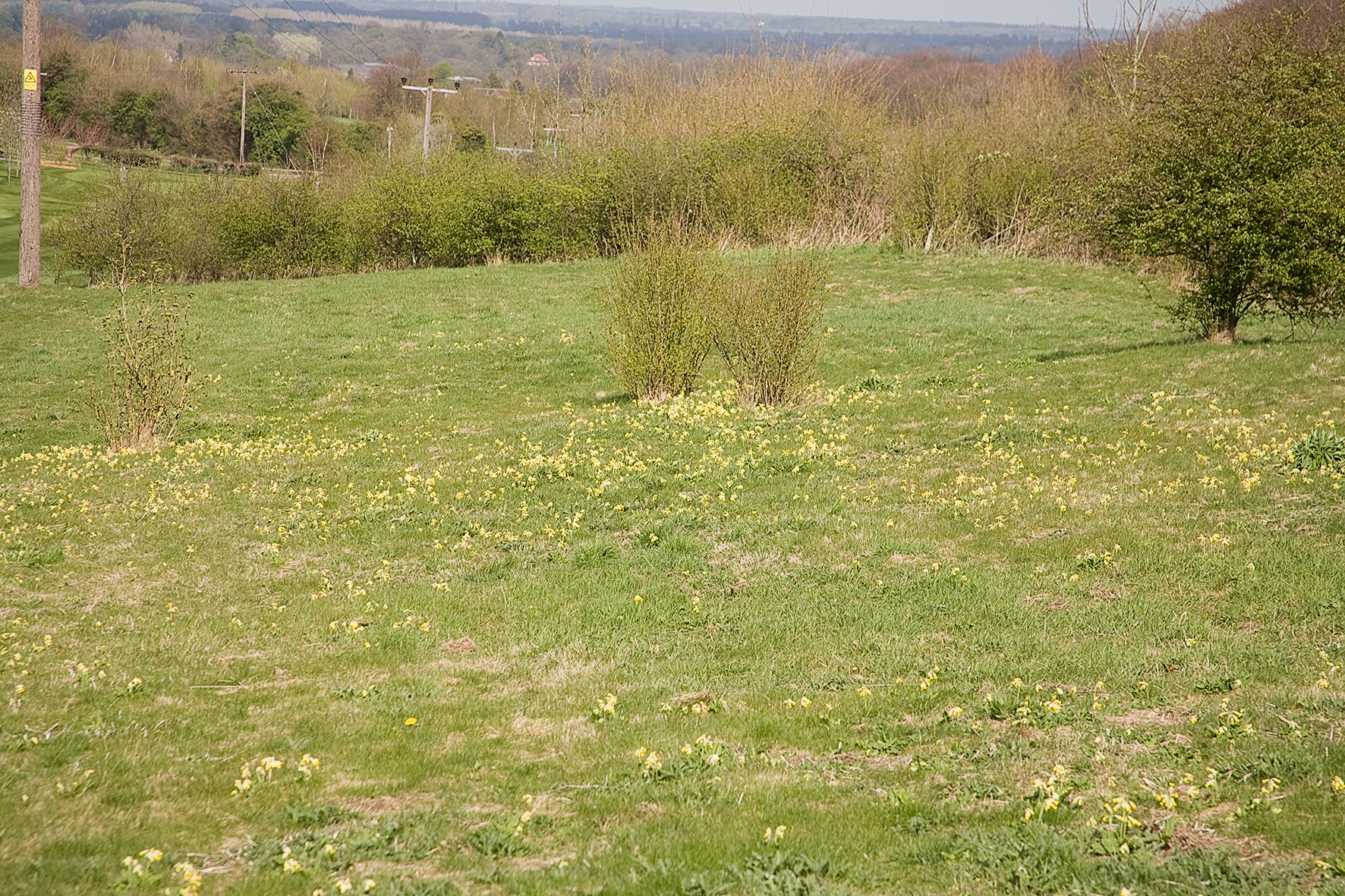 The short grass after the Autumn cut-and-collect suits these cowslips very well (above). Even in high summer, the grass is not tall and dense and the range of wild flowers is pretty impressive (below).
The short grass after the Autumn cut-and-collect suits these cowslips very well (above). Even in high summer, the grass is not tall and dense and the range of wild flowers is pretty impressive (below).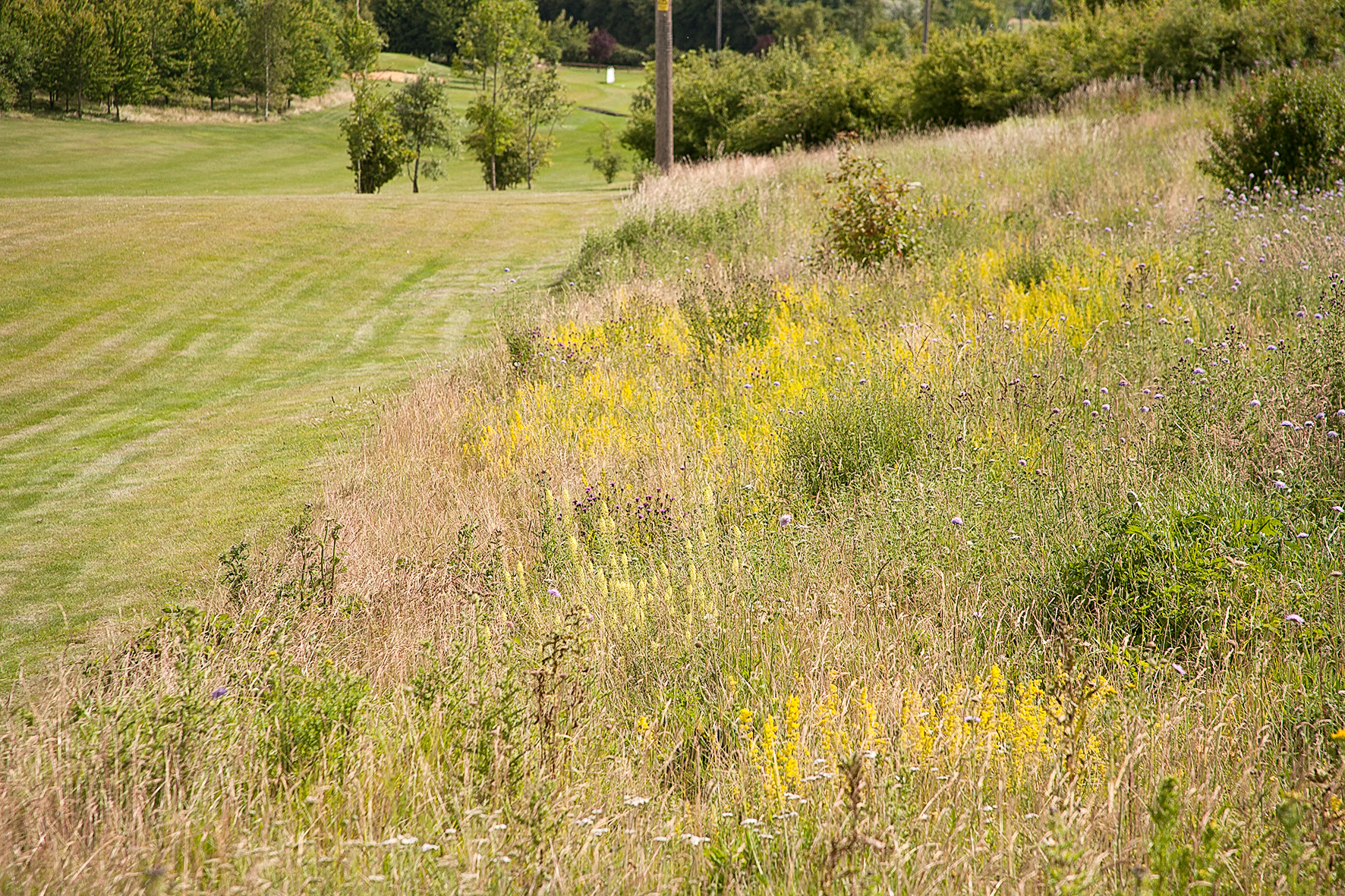 One factor which is in the control of clubs is to understand what plants are growing in the rough and, if they are not providing any physical hazard, to enjoy their presence. The ‘clean, bright green grass’ brigade, with weedkiller sprayed everywhere, are certainly not a positive factor for biodiversity. It is even possible, following effective scarifying, to increase the floral diversity by sowing a range of flower species, providing that the plants which are chosen are suitable for the soil, light conditions and required management. Advising on this is a specialist’s job, one with both agronomic and botanical skills. The vast majority of ‘pollinator mixtures’ being offered by seed houses, being based on annuals, are NOT suitable and it is unlikely that the normal seed salesman will have the necessary knowledge to advise. Again the Emorsgate website has very good information, as do a handful of other specialist firms.
When deliberately sowing wild flowers it is important to use low-growing species which will thrive under a level of mowing rather more frequent that the average farm flower margin. Research led by the Centre For Ecology and Hydrology at Wallingford has shown that it is not necessary to sow a high density of seed. Provided the ongoing management is correct, there is little - if any - difference between high density and low density sowings after 5 years. The correct grass mixture/conditions are critical, however. It should also be noted that lighter soils, be they acid or alkaline, are generally easier to manage than heavy clay soils where the frequency of mowing/scarifying is likely to need to be rather higher, especially if an area has a history of having been fertilised, such as courses established on ex-arable soils, or where green and tee cuttings have been dumped in the past.
One factor which is in the control of clubs is to understand what plants are growing in the rough and, if they are not providing any physical hazard, to enjoy their presence. The ‘clean, bright green grass’ brigade, with weedkiller sprayed everywhere, are certainly not a positive factor for biodiversity. It is even possible, following effective scarifying, to increase the floral diversity by sowing a range of flower species, providing that the plants which are chosen are suitable for the soil, light conditions and required management. Advising on this is a specialist’s job, one with both agronomic and botanical skills. The vast majority of ‘pollinator mixtures’ being offered by seed houses, being based on annuals, are NOT suitable and it is unlikely that the normal seed salesman will have the necessary knowledge to advise. Again the Emorsgate website has very good information, as do a handful of other specialist firms.
When deliberately sowing wild flowers it is important to use low-growing species which will thrive under a level of mowing rather more frequent that the average farm flower margin. Research led by the Centre For Ecology and Hydrology at Wallingford has shown that it is not necessary to sow a high density of seed. Provided the ongoing management is correct, there is little - if any - difference between high density and low density sowings after 5 years. The correct grass mixture/conditions are critical, however. It should also be noted that lighter soils, be they acid or alkaline, are generally easier to manage than heavy clay soils where the frequency of mowing/scarifying is likely to need to be rather higher, especially if an area has a history of having been fertilised, such as courses established on ex-arable soils, or where green and tee cuttings have been dumped in the past.
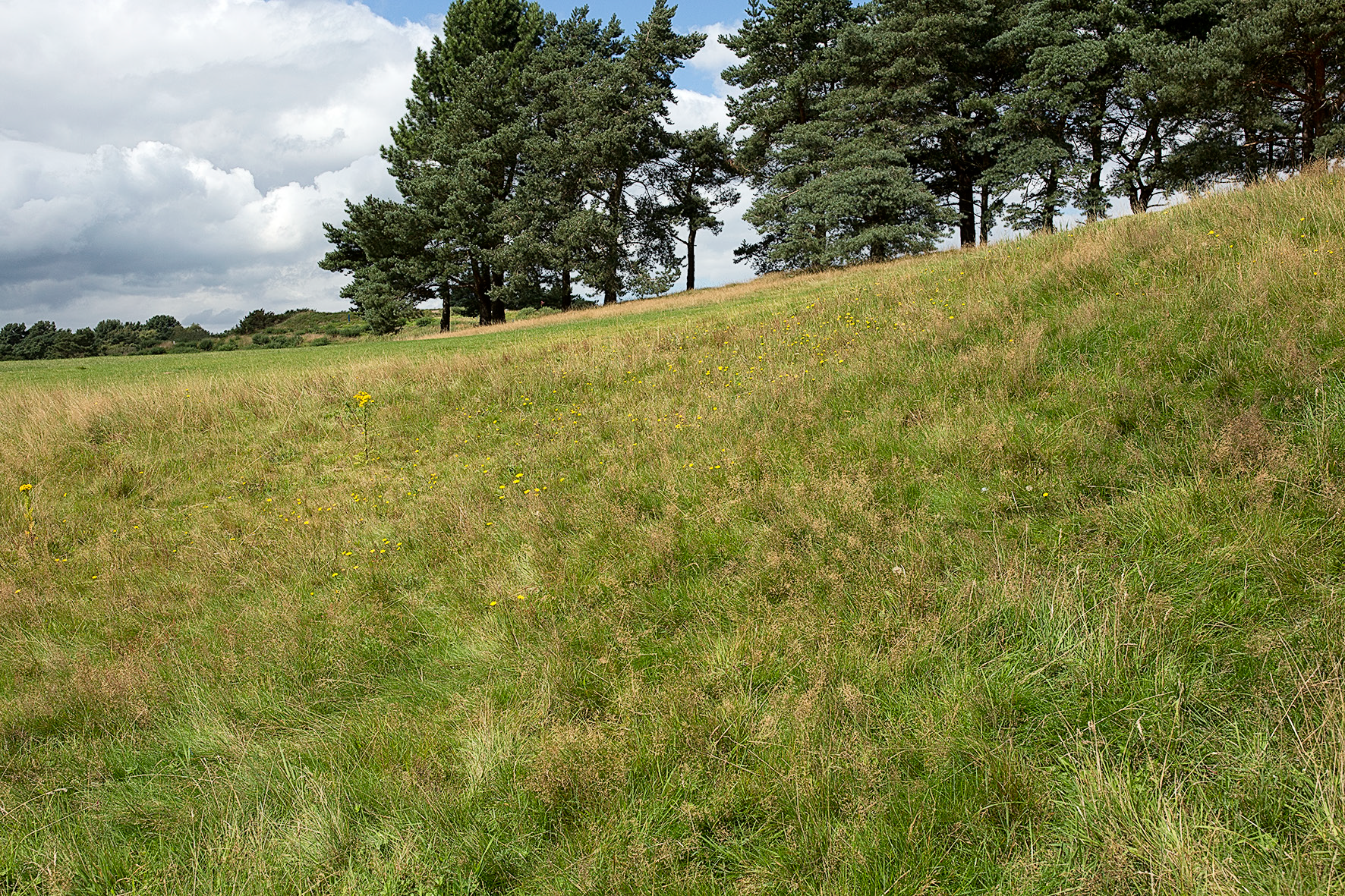 This is about as tall as a playable rough should get - this one would be improved with a bit more scarifying to open the
This is about as tall as a playable rough should get - this one would be improved with a bit more scarifying to open the


